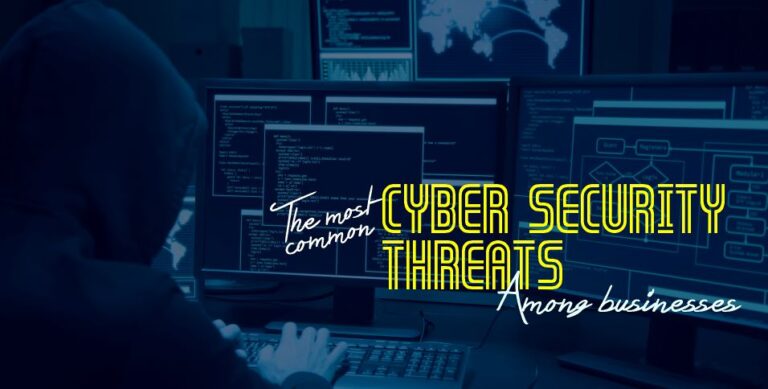Most people think that cyber security threats only target billion-dollar companies, but small and medium-sized businesses can also be victims. In most cases, businesses with poor security measures are more vulnerable.
While attacks may happen overnight, some may take days. If not, it may take months or weeks to be discovered. The key is working with experts like https://cpcyber.com/ to avoid such threats and protect your business. Awareness of various cyber security threats may also help you further monitor potential threats and safeguard your company.

Below are some of the common cyber security threats you should know:
1. Phishing
Phishing attacks are the most widespread and damaging cyber security threats among businesses. Typically, a phishing attack occurs when hackers pretend to be trusted contacts and entice users to click malicious links, download files, or provide access to sensitive data, credentials, or account details.
Due to the rise of cyber attacks, phishing threats have grown more sophisticated as many attackers become more effective in pretending to be reputable business contacts. There has also been an increase in business email compromise, which involves phishing campaigns to get account passwords from executives and using such accounts to request fraud payments from employees.
One of the reasons phishing attacks can be damaging is that they’re hard to combat. Fortunately, there are some solutions that business owners can consider. For example, businesses can use a reliable email security gateway to enhance security and protect emails from potential phishing attacks.
It’s also an excellent strategy to take advantage of free anti-phishing add-ons. These days, most browsers will let you download add-ons that alert you about phishing or malicious websites. They’re usually free, so there’s no reason not to install them on every computer in your company.
2. Malware
There are instances where phishing and malware attacks may go hand in hand. However, malware refers to malicious software made to execute attacks on the servers or devices that run or download it. Often, malware attacks may shut down your company’s entire system or corrupt your data.
Like phishing, malware may trick users into clicking on links or installing programs. These programs may then track keystrokes, self-replicate, block access, hijack your company’s system resources, and perform other compromising activities.
When dealing with malware, there are some things you can do, and these include the following:
- Inspect email sender and content to determine whether or not they’re reliable.
- Update your device and install anti-malware software.
- Automate your data backup so you can restore your files quickly in case of data corruption or loss.
- Create a plan to manage and deal with malware attacks.
- Open software and files from trusted sources only.
3. Insider Threats
An insider threat is another common cyber security problem that most businesses face. More often than not, losses from insider threats can be significant because insiders know where to search or obtain access. Plus, insiders know how to get through your company’s existing security measures. Even if the severity and possibility of this threat are known and real, not all businesses pay attention to solving this issue.
Remember that your employees can be the weak link to your network security, and it’s crucial to provide them with proper training to stay vigilant. Discussing your policy often and clearly, monitoring suspicious or unusual activities and well-documented off-boarding are some ways to help your business minimize the risks involved in insider threats.
4. Distributed Denial of Service
A Distributed Denial of Service (DDoS) attack is a known cyber security threat that happens when attackers flood the different systems with unrelenting bandwidth, resulting in a system crash. To execute DDoS attacks, criminals usually spread malicious software to vulnerable devices using infected attachments and emails. Then, they’ll create networks of infected machines called a botnet.
Attackers will control the botnet and direct it to flood the target with unusual waves of internet traffic. As a result, the target network will stop working, shutting down your company’s system.
To prevent possible DDoS attacks, businesses can implement intrusion detection systems and firewalls that serve as traffic-scanning barriers between networks. Combining these solutions with anti-malware and anti-virus software that removes and detects malware and viruses is also an excellent idea.
5. Ransomware
Ransomware is malware that takes your personal information and company’s sensitive data hostage until the ransom is paid. In some instances, this attack may threaten to publish your confidential data, while in other cases, it blocks access or encrypts your data altogether.
Ransomware attacks frequently find their way into companies through phishing emails. All it needs is a click on links to emails sent to the victim to obtain access. Without the users even realizing it, the malware makes its way into the system, and the attack will occur immediately.
Luckily, businesses can now quickly detect ransomware. Training employees in cyber security threats makes combating attacks and hindering cyber criminals possible.
Businesses can also use anti-virus and malware-scanning software to intercept Trojan messages before reaching the employees. Such programs can highlight potential threats, prevent downloads, and quarantine emails.
If ransomware gets through, an effective defense is to have a recovery plan. It requires the maintenance of backups in various off-site locations. It means business owners need a backup that’s not connected to the computer systems in any way, so they’re entirely immune to possible attacks. Although ransomware may still cost you more time to restore your company system, at least it won’t cost you millions of dollars.
6. Social Engineering
A social engineering attack exploits social interactions to acquire access to valuable or sensitive data. Deception is at the root of this cyber security threat. Most cyber fraudsters trick the targets into taking particular actions, such as disclosing sensitive information or bypassing security measures.
Even the most advanced cyber security solutions can’t combat social engineering attacks. It’s because the targets let criminals into the system mindlessly. Therefore, organizations must prepare for this threat and create a better strategy to prevent social engineering attacks.
Conclusion
As technology continues to evolve, cyber security threats also become more complicated. To protect your business, you have to stay persistent in your company’s data management practices, and it’s equally essential for your employees to comply with your cyber security policy. In addition, understanding and learning about the current cyber security threats among businesses is crucial to creating and implementing an effective solution.
Also Read: Common Cyber Security Measures: Which One To Choose?















